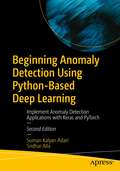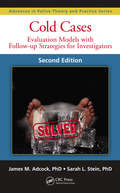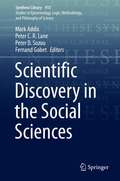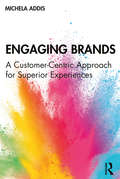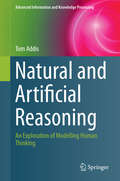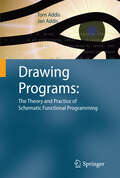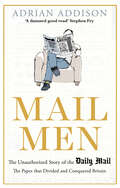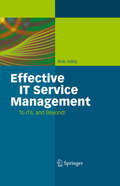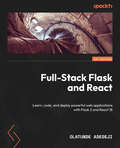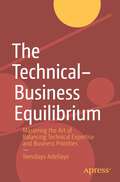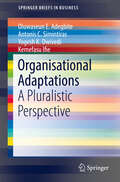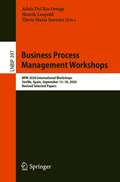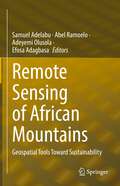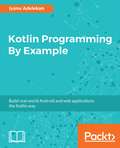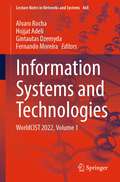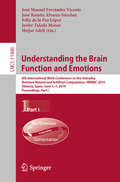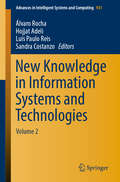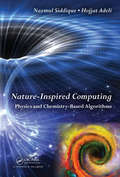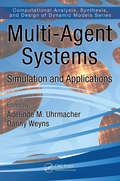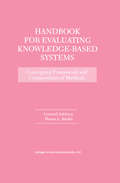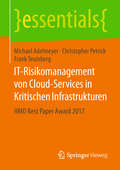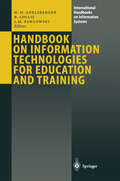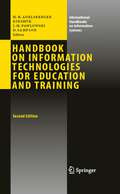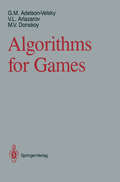- Table View
- List View
Beginning Anomaly Detection Using Python-Based Deep Learning: Implement Anomaly Detection Applications with Keras and PyTorch
by Suman Kalyan Adari Sridhar AllaThis beginner-oriented book will help you understand and perform anomaly detection by learning cutting-edge machine learning and deep learning techniques. This updated second edition focuses on supervised, semi-supervised, and unsupervised approaches to anomaly detection. Over the course of the book, you will learn how to use Keras and PyTorch in practical applications. It also introduces new chapters on GANs and transformers to reflect the latest trends in deep learning. Beginning Anomaly Detection Using Python-Based Deep Learning begins with an introduction to anomaly detection, its importance, and its applications. It then covers core data science and machine learning modeling concepts before delving into traditional machine learning algorithms such as OC-SVM and Isolation Forest for anomaly detection using scikit-learn. Following this, the authors explain the essentials of machine learning and deep learning, and how to implement multilayer perceptrons for supervised anomaly detection in both Keras and PyTorch. From here, the focus shifts to the applications of deep learning models for anomaly detection, including various types of autoencoders, recurrent neural networks (via LSTM), temporal convolutional networks, and transformers, with the latter three architectures applied to time-series anomaly detection. This edition has a new chapter on GANs (Generative Adversarial Networks), as well as new material covering transformer architecture in the context of time-series anomaly detection. After completing this book, you will have a thorough understanding of anomaly detection as well as an assortment of methods to approach it in various contexts, including time-series data. Additionally, you will have gained an introduction to scikit-learn, GANs, transformers, Keras, and PyTorch, empowering you to create your own machine learning- or deep learning-based anomaly detectors. What You Will Learn Understand what anomaly detection is, why it it is important, and how it is appliedGrasp the core concepts of machine learning.Master traditional machine learning approaches to anomaly detection using scikit-kearn.Understand deep learning in Python using Keras and PyTorchProcess data through pandas and evaluate your model's performance using metrics like F1-score, precision, and recallApply deep learning to supervised, semi-supervised, and unsupervised anomaly detection tasks for tabular datasets and time series applications Who This Book Is For Data scientists and machine learning engineers of all levels of experience interested in learning the basics of deep learning applications in anomaly detection.
Cold Cases: Evaluation Models with Follow-up Strategies for Investigators, Second Edition
by James M. Adcock Sarah L. SteinBecause the investigation of cold cases is usually an arduous and time-consuming task, most law enforcement agencies in the United States are not able to dedicate the resources necessary to support the cold case investigation process. However, when those cases are fully pursued and prosecuted, they often result in convictions and lengthy prison ter
Scientific Discovery in the Social Sciences (Synthese Library #413)
by Mark Addis Peter C. R. Lane Peter D. Sozou Fernand GobetThis volume offers selected papers exploring issues arising from scientific discovery in the social sciences. It features a range of disciplines including behavioural sciences, computer science, finance, and statistics with an emphasis on philosophy.The first of the three parts examines methods of social scientific discovery. Chapters investigate the nature of causal analysis, philosophical issues around scale development in behavioural science research, imagination in social scientific practice, and relationships between paradigms of inquiry and scientific fraud. The next part considers the practice of social science discovery. Chapters discuss the lack of genuine scientific discovery in finance where hypotheses concern the cheapness of securities, the logic of scientific discovery in macroeconomics, and the nature of that what discovery with the Solidarity movement as a case study. The final part covers formalising theories in social science. Chapters analyse the abstract model theory of institutions as a way of representing the structure of scientific theories, the semi-automatic generation of cognitive science theories, and computational process models in the social sciences.The volume offers a unique perspective on scientific discovery in the social sciences. It will engage scholars and students with a multidisciplinary interest in the philosophy of science and social science.
Engaging Brands: A Customer-Centric Approach for Superior Experiences
by Michela AddisHow can managers design and manage excellent customer experiences that will develop long-term relationships with their customers? This book addresses this key question and explores both the theory developed over the past 20 years and tools to create truly engaging brands. Taking a broad holistic approach, this book brings together current thinking on experiential marketing, brand management, customer engagement, customer well-being and happiness, customer loyalty and emotions, the customer journey map, and big data and combines it into a practical and clear roadmap for brand managers. By integrating these modern perspectives, concepts, research techniques, and operative tools, this book provides a new perspective of marketing management to design and build engaging branding. Using extensive examples from a variety of industries, this book offers a global perspective that will appeal to both advanced students and experienced marketing managers.
Engaging Brands: A Customer-Centric Approach for Superior Experiences
by Michela AddisHow can managers design and manage excellent customer experiences that will develop long-term relationships with their customers? This book addresses this key question and explores both the theory developed over the past 20 years and tools to create truly engaging brands. Taking a broad holistic approach, this book brings together current thinking on experiential marketing, brand management, customer engagement, customer well-being and happiness, customer loyalty and emotions, the customer journey map, and big data and combines it into a practical and clear roadmap for brand managers. By integrating these modern perspectives, concepts, research techniques, and operative tools, this book provides a new perspective of marketing management to design and build engaging branding. Using extensive examples from a variety of industries, this book offers a global perspective that will appeal to both advanced students and experienced marketing managers.
Natural and Artificial Reasoning: An Exploration of Modelling Human Thinking (Advanced Information and Knowledge Processing)
by Tom AddisWhat are the limitations of computer models and why do we still not have working models of people that are recognizably human? This is the principle puzzle explored in this book where ideas behind systems that behave intelligently are described and different philosophical issues are touched upon.The key to human behavior is taken to be intelligence and the ability to reason about the world. A strong scientific approach is taken, but first it was required to understand what a scientific approach could mean in the context of both natural and artificial systems. A theory of intelligence is proposed that can be tested and developed in the light of experimental results. The book illustrates that intelligence is much more than just behavior confined to a unique person or a single computer program within a fixed time frame. Some answers are unraveled and some puzzles emerge from these investigations and experiments.Natural and Artificial Reasoning provides a few steps of an exciting journey that began many centuries ago with the word ‘why?’
Drawing Programs: The Theory and Practice of Schematic Functional Programming
by Tom Addis Jan AddisDrawing Programs: The Theory and Practice of Schematic Functional Programming describes a diagrammatic (schematic) approach to programming. It introduces a sophisticated tool for programmers who would rather work with diagrams than with text. The language is a complete functional language that has evolved into a representation scheme that is unique. The result is a simple coherent description of the process of modelling with the computer. The experience of using this tool is introduced gradually with examples, small projects and exercises. The new computational theory behind the tool is interspersed between these practical descriptions so that the reasons for the activity can be understood and the activity, in turn, illustrates some elements of the theory Access to the tool, its source code and a set of examples that range from the simple to the complex is free (see www.springer.com/978-1-84882-617-5). A description of the tool’s construction and how it may be extended is also given. The authors’ experience with undergraduates and graduates who have the understanding and skill of a functional language learnt through using schema have also shown an enhanced ability to program in other computer languages. Readers are provided with a set of concepts that will ensure a good robust program design and, what is more important, a path to error free programming.
Mail Men: The Unauthorized Story of the Daily Mail - The Paper that Divided and Conquered Britain
by Adrian AddisonMail Men is the gripping, unofficial story of an institution that has become the self-proclaimed voice of middle England, and the adversary of liberals everywhere. Journalist Adrian Addison investigates the secret behind the Mail's extraordinary longevity and commercial success but also examines the controversies that have beset the paper - from its owner's flirtation with fascism in the 1930s to its fractious relationship with liberals, celebrities and politicians today. Revelatory and captivating, this book also gets under the skin of Paul Dacre, the once awkward reporter who has become one of the most feared, hated, secretive, and respected editors in Britain. This is an essential read if you wish to understand modern Britain.
Effective IT Service Management: To ITIL and Beyond!
by Rob AddyIT service management (ITSM) is the group of processes and functions that oil the wheels of the IT machine. Without ITSM, every IT project and system would deteriorate over time until failure. ITIL is the recognized best-practice standard for ITSM, and has been around since the late 1980s, with ITIL version 3 published just recently. However, many of today’s IT problems have been around for just as long - so in order to manage IT effectively, organizations must go beyond the ITIL framework. Rob Addy provides IT service managers and professionals with practical guidance on delivering and managing IT services in an effective and efficient manner by extending the ITIL approach to deliver proactive and pragmatic IT service management. His book is a candid look at the relative merits of currently accepted wisdom regarding the provision of IT services, using the principles of the IT Infrastructure Library (ITIL) guidance series. It describes IT service management processes related to service delivery and service support (as well as other non-ITIL areas), their objectives, shortcomings, and how these issues can be addressed in real-life situations. In addition, it delivers a workable definition of what exactly an ‘IT service’ is and how it can be defined and used in practice. Overall, he gives an unbiased view of the discipline, its objectives, major processes, and their benefits and shortcomings. Managing and mitigating IT risk is critical to the survival of every business. Success is an optional extra! Proactive IT service management can be thought of as risk management for IT: Can you afford to ignore it?
Full-Stack Flask and React: Learn, code, and deploy powerful web applications with Flask 2 and React 18
by Olatunde AdedejiGet to grips with UI interaction, data modeling, API development, and documentation while building modern web apps for cloud deploymentKey FeaturesCombine Flask's pagination techniques with React's dynamic rendering for an enhanced user experienceImplement robust API development within Flask applications by performing CRUD operationsImprove Flask app scalability with blueprints using a modular development approachPurchase of the print or Kindle book includes a free PDF eBookBook DescriptionDeveloping an interactive, efficient, and fast enterprise web application requires both the right approach and tooling. If you are a web developer looking for a way to tap the power of React’s reusable UI components and the simplicity of Flask for backend development to develop production-ready, scalable web apps in Python, then this book is for you. Starting with an introduction to React, a JavaScript library for building highly interactive and reusable user interfaces, you’ll progress to data modeling for the web using SQLAlchemy and PostgreSQL, and then get to grips with Restful API development. This book will aid you in identifying your app users and managing access to your web application. You’ll also explore modular architectural design for Flask-based web applications and master error-handling techniques. Before you deploy your web app on AWS, this book will show you how to integrate unit testing best practices to ensure code reliability and functionality, making your apps not only efficient and fast but also robust and dependable. By the end of this book, you’ll have acquired deep knowledge of the Flask and React technology stacks, which will help you undertake web application development with confidence.What you will learnExplore the fundamentals of React for building user interfacesUnderstand how to use JSX to render React componentsHandle data and integrate third-party libraries and APIs into React applicationsSecure your Flask application with user authentication and authorizationDiscover how to use Flask RESTful API to build backend services with React frontendBuild modular and scalable Flask applications using blueprintsWho this book is forThis book is for Python web developers who want to build full-stack applications, as well as for frontend developers seeking to expand their skillset by employing Flask as a backend development tool. You’ll gain proficiency in both frontend and backend skills, and acquire the knowledge necessary to deploy solutions in the cloud using AWS. Prior knowledge of basic HTML, CSS, JavaScript, and Python programming will help you to get the most out of this book.
The Technical–Business Equilibrium: Mastering the Art of Balancing Technical Expertise and Business Priorities
by Temidayo AdefioyeLearn how to make the right technical decisions to achieve your organization's business objectives. This book is a guide for software engineers who are responsible for making technical decisions that impact the business objectives of their organization. You'll start by reviewing business priorities, technical decision-making, and see how to overcome common challenges. Using real world case studies, this book offers a comprehensive overview of the skills and strategies required for senior engineers to effectively navigate complex technical and business challenges. You will also gain advice on building trust and credibility with business stakeholders and communicating technical challenges and opportunities to them.The Technical-Business Equilibrium reveals practical strategies for assessing technical feasibility and risk, selecting the best solutions to meet your company's goals, and communicating those decisions to business stakeholders. What You Will Learn Utilize techniques for evaluating technical feasibility and riskCommunicate technical decisions to business stakeholders clearly and effectivelyGain insights into managing competing prioritiesManage technical debts and build a solid engineering culture Who This Book is For Senior engineers with several years of experience in the software development industry who have most likely advanced through the ranks of technical roles and are now in positions of leadership or decision-making within their organization.
Organisational Adaptations: A Pluralistic Perspective (SpringerBriefs in Business)
by Oluwaseun E. Adegbite Antonis C. Simintiras Yogesh K. Dwivedi Kemefasu IfieThis book explores how enterprises adapt to challenges in their business environments. It focuses on the critical elements within organisations that every executive must address in order to remain competitive. It takes a pluralist approach in trying to broaden our knowledge on organisational adaptations. It also offers an exploratory delve into existing literature of organisational study. This is biased for content, context and process framework and processual analytic approach in order to identify, determine, understand the intricacies of adaptations going on in various business organisations. The book also includes a case study of how Kodak and Fujifilm responded to digitalisation of photographic film industry, which is an example of major adaptation change. Many global brands are often contending with similar issues and real life challenges. Simply put, today’s business environment demands a new way of doing business that challenges brand’s existing core business philosophy.Organisations are ‘individual’ entities in their own rights. Businesses have devised ways of surviving their environments. They do this by downsizing, merger and acquisition, business ecosystems, other forms of collaborations and strategic alliances. While this is true, current research works into generic predictors and/or concepts that enhance the transformation process are scarce. It is particularly important to align the theories and concepts of organisational adaptations with realities in the business environment. This book delves deep and explains adaptations in organisations, but also offers insight for how executives can adapt and thrive in their dynamic business environments.
Business Process Management Workshops: BPM 2020 International Workshops, Seville, Spain, September 13–18, 2020, Revised Selected Papers (Lecture Notes in Business Information Processing #397)
by Adela Del Río Ortega Henrik Leopold Flávia Maria SantoroThis book constitutes revised papers from the International Workshops held at the 18th International Conference on Business Process Management, BPM 2020, during September 13-18, 2020. The conference was planned to take place in Seville, Spain, but changed to an online format due to the COVID-19 pandemic.Papers from the following workshops are included: Workshop on Security and Privacy-Enhanced Business Process Management (SPBP 2020) Workshop on Social and Human Aspects of Business Process Management (BPMS2 2020) Workshop on Business Processes Meet the Internet-of Things (BP-Meet-IoT 2020) Workshop on Artificial Intelligence for Business Process Management (AI4BPM 2020) Workshop BPM in the Era of Digital Innovation and Transformation (BPMinDIT 2020) Workshop on Business Process Intelligence (BPI 2020) Workshop on Declarative, Decision and Hybrid Approaches to Processes (DEC2H 2020) Each of the seven workshops focused on particular aspects of business process management, either from a technical or from a domain perspective. Overall, after a thorough review process there were 28 full and 1 short paper selected from 53 submissions.
Remote Sensing of African Mountains: Geospatial Tools Toward Sustainability
by Samuel Adelabu Abel Ramoelo Adeyemi Olusola Efosa AdagbasaThis edited volume focuses on the use of remote sensing techniques to assess and monitor mountainous ecosystems in Africa, with a focus on tracking changes related to climate change and human activity. The book is timely, as the interaction of mountain environmental dynamics with conservation and sustainability is an under-researched issue. The chapters in this volume use remotely sensed data to study a variety of topics related to mountains and their ecosystems, including but not limited to vegetation, energy systems, environmental hazards, ecosystem services, diseases, climatic shifts, geological formations and geomorphological dynamics. The ability to monitor, assess and analyze mountainous regions is aided by the availability of remote sensing products such as optical and microwave sensors and low-cost unmanned aerial vehicles (UAVs). The works presented here push the frontier of knowledge on mountain studies and will help shape local, national and global assessments and policies, including efforts toward the achievement of the African Agenda 2063. The book will be of interest to researchers and students in remote sensing, geography, ecology and sustainability, as well as to government organizations and conservation specialists.
Kotlin Programming By Example: Build Real-world Android And Web Applications The Kotlin Way
by Iyanu AdelekanKotlin greatly reduces source code verbosity; with the recently announced first class support from the Android team, a great opportunity has been created. The book will help you learn how to create apps with Kotlin from scratch and get them up-and-running.
Information Systems and Technologies: WorldCIST 2022, Volume 1 (Lecture Notes in Networks and Systems #468)
by Hojjat Adeli Gintautas Dzemyda Alvaro Rocha Fernando MoreiraThis book covers the following main topics: A) information and knowledge management; B) organizational models and information systems; C) software and systems modeling; D) software systems, architectures, applications and tools; E) multimedia systems and applications; F) computer networks, mobility and pervasive systems; G) intelligent and decision support systems; H) big data analytics and applications; I) human–computer interaction; J) ethics, computers and security; K) health informatics; L) information technologies in education; M) information technologies in radio communications; N) technologies for biomedical applications.This book is composed by a selection of articles from The 2022 World Conference on Information Systems and Technologies (WorldCIST'22), held between April 12 and 14, in Budva, Montenegro.WorldCIST is a global forum for researchers and practitioners to present and discuss recent results and innovations, current trends, professional experiences, and challenges of modern information systems and technologies research, together with their technological development and applications.
Understanding the Brain Function and Emotions: 8th International Work-Conference on the Interplay Between Natural and Artificial Computation, IWINAC 2019, Almería, Spain, June 3–7, 2019, Proceedings, Part I (Lecture Notes in Computer Science #11486)
by Hojjat Adeli José Manuel Ferrández Vicente José Ramón Álvarez-Sánchez Félix de la Paz López Javier Toledo MoreoThe two volume set LNCS 11486 and 11487 constitutes the proceedings of the International Work-Conference on the Interplay Between Natural and Artificial Computation, IWINAC 2019, held in Almería, Spain,, in June 2019. The total of 103 contributions was carefully reviewed and selected from 190 submissions during two rounds of reviewing and improvement. The papers are organized in two volumes, one on understanding the brain function and emotions, addressing topics such as new tools for analyzing neural data, or detection emotional states, or interfacing with physical systems. The second volume deals with bioinspired systems and biomedical applications to machine learning and contains papers related bioinspired programming strategies and all the contributions oriented to the computational solutions to engineering problems in different applications domains, as biomedical systems, or big data solutions.
New Knowledge in Information Systems and Technologies: Volume 2 (Advances in Intelligent Systems and Computing #931)
by Hojjat Adeli Álvaro Rocha Luís Paulo Reis Sandra CostanzoThis book includes a selection of articles from The 2019 World Conference on Information Systems and Technologies (WorldCIST’19), held from April 16 to 19, at La Toja, Spain.WorldCIST is a global forum for researchers and practitioners to present and discuss recent results and innovations, current trends, professional experiences and challenges in modern information systems and technologies research, together with their technological development and applications.The book covers a number of topics, including A) Information and Knowledge Management; B) Organizational Models and Information Systems; C) Software and Systems Modeling; D) Software Systems, Architectures, Applications and Tools; E) Multimedia Systems and Applications; F) Computer Networks, Mobility and Pervasive Systems; G) Intelligent and Decision Support Systems; H) Big Data Analytics and Applications; I) Human–Computer Interaction; J) Ethics, Computers & Security; K) Health Informatics; L) Information Technologies in Education; M) Information Technologies in Radiocommunications; and N) Technologies for Biomedical Applications.
Nature-Inspired Computing: Physics and Chemistry-Based Algorithms
by Hojjat Adeli Nazmul H. SiddiqueNature-Inspired Computing: Physics and Chemistry-Based Algorithms provides a comprehensive introduction to the methodologies and algorithms in nature-inspired computing, with an emphasis on applications to real-life engineering problems. The research interest for Nature-inspired Computing has grown considerably exploring different phenomena observed in nature and basic principles of physics, chemistry, and biology. The discipline has reached a mature stage and the field has been well-established. This endeavour is another attempt at investigation into various computational schemes inspired from nature, which are presented in this book with the development of a suitable framework and industrial applications. Designed for senior undergraduates, postgraduates, research students, and professionals, the book is written at a comprehensible level for students who have some basic knowledge of calculus and differential equations, and some exposure to optimization theory. Due to the focus on search and optimization, the book is also appropriate for electrical, control, civil, industrial and manufacturing engineering, business, and economics students, as well as those in computer and information sciences. With the mathematical and programming references and applications in each chapter, the book is self-contained, and can also serve as a reference for researchers and scientists in the fields of system science, natural computing, and optimization.
Multi-Agent Systems: Simulation and Applications (Computational Analysis, Synthesis, and Design of Dynamic Systems)
by Adelinde M. Uhrmacher and Danny WeynsMethodological Guidelines for Modeling and Developing MAS-Based SimulationsThe intersection of agents, modeling, simulation, and application domains has been the subject of active research for over two decades. Although agents and simulation have been used effectively in a variety of application domains, much of the supporting research remains scattered in the literature, too often leaving scientists to develop multi-agent system (MAS) models and simulations from scratch. Multi-Agent Systems: Simulation and Applications provides an overdue review of the wide ranging facets of MAS simulation, including methodological and application-oriented guidelines. This comprehensive resource reviews two decades of research in the intersection of MAS, simulation, and different application domains. It provides scientists and developers with disciplined engineering approaches to modeling and developing MAS-based simulations. After providing an overview of the field’s history and its basic principles, as well as cataloging the various simulation engines for MAS, the book devotes three sections to current and emerging approaches and applications.Simulation for MAS — explains simulation support for agent decision making, the use of simulation for the design of self-organizing systems, the role of software architecture in simulating MAS, and the use of simulation for studying learning and stigmergic interaction.MAS for Simulation — discusses an agent-based framework for symbiotic simulation, the use of country databases and expert systems for agent-based modeling of social systems, crowd-behavior modeling, agent-based modeling and simulation of adult stem cells, and agents for traffic simulation. Tools — presents a number of representative platforms and tools for MAS and simulation, including Jason, James II, SeSAm, and RoboCup Rescue.Complete with over 200 figures and formulas, this reference book provides the necessary overview of experiences with MAS simulation and the tools needed to exploit simulation in MAS for future research in a vast array of applications including home security, computational systems biology, and traffic management.
Handbook for Evaluating Knowledge-Based Systems: Conceptual Framework and Compendium of Methods
by Leonard Adelman Sharon L. RiedelKnowledge-based systems are increasingly found in a wide variety of settings and this handbook has been written to meet a specific need in their widening use. While there have been many successful applications of knowledge-based systems, some applications have failed because they never received the corrective feedback that evaluation provides for keeping development focused on the users' needs in their actual working environment. This handbook provides a conceptual framework and compendium of methods for performing evaluations of knowledge-based systems during their development. Its focus is on the users' and subject matter experts' evaluation of the usefulness of the system, and not on the developers' testing of the adequacy of the programming code. The handbook permits evaluators to systematically answer the following kinds of questions: Does the knowledge-based system meet the users' task requirements? Is the system easy to use? Is the knowledge base logically consistent? Does it meet the required level of expertise? Does the system improve performance? The authors have produced a handbook that will serve two audiences: a tool that can be used to create knowledge-based systems (practitioners, developers, and evaluators) and a framework that will stimulate more research in the area (academic researchers and students). To accomplish this, the handbook is built around a conceptual framework that integrates the different types of evaluations into the system of development process. The kinds of questions that can be answered, and the methods available for answering them, will change throughout the system development life cycle. And throughout this process, one needs to know what can be done, and what can't. It is this dichotomy that addresses needs in both the practitioner and academic research audiences.
IT-Risikomanagement von Cloud-Services in Kritischen Infrastrukturen: HMD Best Paper Award 2017 (essentials)
by Michael Adelmeyer Christopher Petrick Frank TeutebergDer Einsatz von Cloud-Services birgt neben vielfältigen Vorteilen auch Risiken für die IT-Sicherheit von Unternehmen. Dies gilt insbesondere für Betreiber Kritischer Infrastrukturen, die durch das IT-Sicherheitsgesetz dazu verpflichtet werden, ihre IT besser vor Cyber-Attacken zu schützen. Für ein funktionierendes IT-Risiko- und Sicherheitsmanagement ist daher eine vollständige Identifikation sowie Bewertung der sich aus dem Einsatz von Cloud-Services ergebenden Risiken unerlässlich. Hierzu werden im vorliegenden essential ein Anforderungskatalog an Cloud-Services zur Umsetzung des IT-Sicherheitsgesetzes, ein Framework für das IT-Risikomanagement von Cloud-Services in Kritischen Infrastrukturen sowie Handlungsempfehlungen für Unternehmen präsentiert.Die AutorenMichael Adelmeyer, M.Sc., CISA, ist wissenschaftlicher Mitarbeiter am Fachgebiet für Unternehmensrechnung und Wirtschaftsinformatik (UWI) der Universität Osnabrück. Christopher Petrick, M.Sc., hat Betriebswirtschaftslehre mit den Schwerpunkten Accounting und Management an der Universität Osnabrück studiert. Prof. Dr. Frank Teuteberg ist Leiter des Fachgebiets UWI an der Universität Osnabrück.
Handbook on Information Technologies for Education and Training (International Handbooks on Information Systems)
by Heimo H. Adelsberger Betty Collis Jan Martin PawlowskiThis handbook aims to give readers a thorough understanding of past, current and future research and its application in the field of educational technology. From a research perspective the book allows readers to grasp the complex theories, strategies, concepts, and methods relating to the design, development, implementation, and evaluation of educational technologies. The handbook contains insights based on past experiences as well as future visions and thus amounts to a comprehensive all round guide. It is targeted at researchers and practitioners working with educational technologies.
Handbook on Information Technologies for Education and Training (International Handbooks on Information Systems)
by Heimo H. Adelsberger Kinshuk Jan Martin PawlowskiThis handbook enables readers to gain a deep understanding of past, current, and forthcoming research and applications in the field of educational technology. Readers develop an in-depth understanding of complex theories, strategies, concepts, and methods underlying the design, development, implementation, and evaluation of educational technologies. Discussing both the current state-of-the-art as well as emerging technologies, the handbook serves as a comprehensive guide for researchers and practitioners working in education and training. This Second Edition features completely revised and updated chapters that reflect the latest developments in the field.
Algorithms for Games
by Georgy M. Adelson-Velsky Vladimir L. Arlazarov M.V. DonskoyAlgorithms for Games aims to provide a concrete example of the programming of a two-person game with complete information, and to demonstrate some of the methods of solutions; to show the reader that it is profitable not to fear a search, but rather to undertake it in a rational fashion, make a proper estimate of the dimensions of the "catastrophe", and use all suitable means to keep it down to a reasonable size. The book is dedicated to the study of methods for limiting the extent of a search. The game programming problem is very well suited to the study of the search problem, and in general for multi-step solution processes. With this in mind, the book focuses on the programming of games as the best means of developing the ideas and methods presented. While many of the examples are related to chess, only an elementary knowledge of the game is needed.
